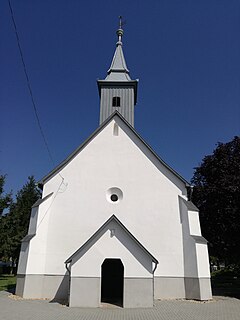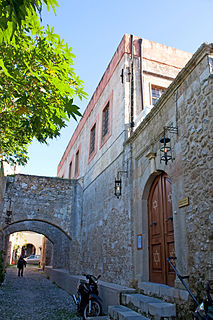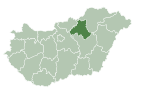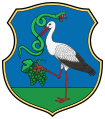
Mezőkövesd[ˈmɛzøːkøvɛʒd] is a town in Borsod-Abaúj-Zemplén county, Northern Hungary. It lies 50 km (31 mi) from Miskolc and 15 km (9 mi) from Eger.

Emőd is a very small town in Borsod-Abaúj-Zemplén county, Northern Hungary, 25 kilometers from county capital Miskolc.

Ajka is a city in Hungary with about 35,000 inhabitants. It is situated in the hills of Bakony.

Plungė is a city in Lithuania with 23,246 inhabitants. Plungė is known for Plungė Manor and its park, Samogitian Art Museum. In the Oginskiai manor park stands the Perkūnas oak a natural monument. The Lourdes of Plungė was created in 1905 and attracts visitors to this day. In the center of Plungė stands a monument for the 10th anniversary of regaining the independence of Lithuania and a sculpture of Saint Florian built by the Lithuanian book carrier Kazys Barzdys.
Trzcianne is a village in Mońki County, Podlaskie Voivodeship, in north-eastern Poland. It is the seat of the gmina called Gmina Trzcianne. It lies approximately 11 kilometres (7 mi) south-west of Mońki and 41 km (25 mi) north-west of the regional capital Białystok. It is close to Biebrza National Park. The village has a population of 610.

The history of the Jews during World War II is almost synonymous with the persecution and murder of Jews which was committed on an unprecedented scale in Europe and European North Africa. The massive scale of the Holocaust which happened during World War II greatly affected the Jewish people and world public opinion, which only understood the dimensions of the Final Solution after the war. The genocide, known as HaShoah in Hebrew, aimed at the elimination of the Jewish people on the European continent. It was a broadly organized operation led by Nazi Germany, in which approximately six million Jews were murdered methodically and with horrifying cruelty. Although the Holocaust was organized by the highest levels of the Nazi German government, the vast majority of Jews murdered were not German, but were instead residents of countries invaded by the Nazis after 1938. Of the approximately 6 million Jews murdered by the Nazis, approximately 160,000 to 180,000 were German Jews. During the Holocaust in occupied Poland, more than one million Jews were murdered in gas chambers of the Auschwitz concentration camp alone. The murder of the Jews of Europe affected Jewish communities in Albania, Austria, Belarus, Belgium, Bosnia & Herzegovina, Channel Islands, Croatia, Czech Republic, Estonia, France, Germany, Greece, Hungary, Italy, Latvia, Libya, Lithuania, Luxembourg, Moldova, the Netherlands, North Macedonia, Norway, Poland, Romania, Russia, Serbia, Slovakia, and Ukraine.
Bácsbokod is a large village and municipality in Bács-Kiskun County, in the Southern Great Plain region of southern Hungary. The Danube River flows 20 kilometers to the west of the village.

Ajak is a town in Szabolcs-Szatmár-Bereg county, in the Northern Great Plain region of eastern Hungary.

Adásztevel is a village in Veszprém county, Hungary.
Alsóvadász is a village in Borsod-Abaúj-Zemplén county, Hungary.

Arló is a village in Borsod-Abaúj-Zemplén county, Hungary.
Bekecs is a village in Borsod-Abaúj-Zemplén County, Hungary.
Csernely is a village in Borsod-Abaúj-Zemplén county, Hungary. The roads leading through the village connect with Csokvaomány, Lénárddaróc and Bükkmogyorósd. The nearest town is Ózd (11 km).

Zalkod is a village in Borsod-Abaúj-Zemplén county, Hungary. In the 19th century, a small Jewish community lived in the village, many of whose members were murdered in the Holocaust There was a Jewish cemetery in the village

Bánhorváti is a village in Borsod-Abaúj-Zemplén county, Hungary. It appeared after Bánfalva and Bánhorvát merged in 1950.

Bánréve is a village in Borsod-Abaúj-Zemplén county, Hungary.

La Juderia,, was the former Jewish quarter of the city of Rhodes, Greece. The quarter was inhabited by Sephardic, Ladino-speaking Jews.
Balsa is a village in Szabolcs-Szatmár-Bereg County, in the Northern Great Plain region of eastern Hungary.
Abasár is a village in Heves county in Hungary, situated near Gyöngyös in the foothills of the Mátra mountains. It was founded as Saár in 1261, and later took the prefix Aba from the Aba clan. To the west of the village is the Sár-hegy, a national nature reserve.

Adács is a village in Heves County, Northern Hungary Region, Hungary.

















